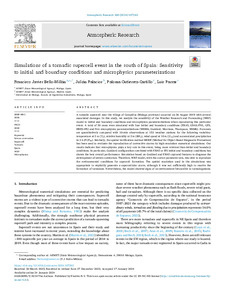Por favor, use este identificador para citar o enlazar este ítem:
http://hdl.handle.net/20.500.11765/16540
Simulations of a tornadic supercell event in the south of Spain: Sensitivity to initial and boundary conditions and microphysics parameterizations
Registro completo de metadatos
| Campo DC | Valor | Lengua/Idioma |
|---|---|---|
| dc.contributor.author | Bello Millán, Francisco Javier | es_ES |
| dc.contributor.author | Palacios García, Julián | es_ES |
| dc.contributor.author | Gutiérrez Castillo, Paloma | es_ES |
| dc.contributor.author | Parras, Luis | es_ES |
| dc.date.accessioned | 2025-01-30T11:19:11Z | - |
| dc.date.available | 2025-01-30T11:19:11Z | - |
| dc.date.issued | 2024 | - |
| dc.identifier.citation | Atmospheric Research. 2024, 300, 107262 | - |
| dc.identifier.issn | 0169-8095 | - |
| dc.identifier.uri | http://hdl.handle.net/20.500.11765/16540 | - |
| dc.description.abstract | A tornadic supercell near the village of Campillos (Malaga province) occurred on 26 August 2019 with several associated damages. In this study, we analyze the sensitivity of the Weather Research and Forecasting (WRF) model to initial and boundary conditions and microphysics parameterizations when reproducing this particular event. A total of 20 cases were simulated with four initial and boundary conditions (ERA5, GDAS/FNL, GFS, HRES-IFS) and five microphysics parameterizations (WDM6, Goddard, Morrison, Thompson, WSM6). Forecasts are quantitatively compared with 10-min observations at 153 weather stations for the following variables: temperature at 2 m (T2), relative humidity at 2 m (RH2), wind speed at 10 m (U10) and accumulated precipitation in 3 h (PCP3h). Similarly, the spatial verification method MODE (Method for Object-Based Diagnostic Evaluation) has been used to evaluate the reproduction of convective storms by high-resolution numerical simulations. Our results indicate that microphysics plays a key role in this event, being more relevant than initial and boundary conditions. In particular, Goddard configuration combined with ERA5 or IFS initial and boundary conditions has shown the best overall performance. Simulation based on Goddard and ERA5 captured features to diagnose the development of severe convection. Therefore, WRF model, with the correct parameter sets, was able to reproduce the environmental conditions for supercell formation. The spatial resolution used in the simulations was appropriate to explicitly generate a supercellular storm, although it was not sufficiently high to resolve the formation of tornadoes. Nevertheless, the model showed signs of an environment favourable to tornadogenesis. | es_ES |
| dc.language.iso | eng | es_ES |
| dc.publisher | Elsevier | es_ES |
| dc.rights | Licencia CC: Reconocimiento CC BY | es_ES |
| dc.subject | Severe convection | es_ES |
| dc.subject | Supercell | es_ES |
| dc.subject | Tornado | es_ES |
| dc.subject | Microphysics | es_ES |
| dc.subject | WRF | es_ES |
| dc.title | Simulations of a tornadic supercell event in the south of Spain: Sensitivity to initial and boundary conditions and microphysics parameterizations | es_ES |
| dc.type | info:eu-repo/semantics/article | es_ES |
| dc.relation.publisherversion | https://doi.org/10.1016/j.atmosres.2024.107262 | es_ES |
| dc.rights.accessRights | info:eu-repo/semantics/openAccess | es_ES |
| Colecciones: | Artículos científicos 2023-2026 | |
Ficheros en este ítem:
| Fichero | Descripción | Tamaño | Formato | ||
|---|---|---|---|---|---|
| AR_Bello_2024.pdf | 25,12 MB | Adobe PDF |  Visualizar/Abrir |
Los ítems de Arcimis están protegidos por una Licencia Creative Commons, salvo que se indique lo contrario.





